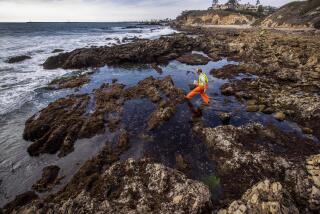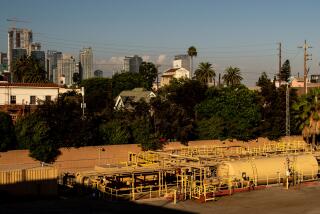5 Spill Cleanup Centers Proposed by Oil Firms
- Share via
Declaring that the petroleum industry has “neither the equipment nor the personnel” to handle a catastrophic tanker spill, 14 major oil companies pledged $250 million Tuesday to create five regional oil spill centers capable of quickly responding to a Valdez-type disaster anywhere in U.S. coastal waters.
The regional response centers, one of which may be located in Long Beach and another in Seattle, are among dozens of recommendations made public in Washington Tuesday by a high-level industry task force organized by the American Petroleum Institute after the disastrous 11-million-gallon spill from the Exxon Valdez in Alaska’s Prince William Sound on March 24. The task force, made up of chief executive officers of eight major oil companies, also called for stepped-up research and development of improved oil spill cleanup equipment and chemical dispersants, and they made a series of recommendations to increase tanker safety.
“The three-part program will provide improved environmental protection wherever tankers operate in U.S. waters,” said Allen E. Murray, who chaired the task force and is president and chief executive officer of the Mobil Corp.
While industry executives said their initiative was “the right thing to do,” they left little doubt that they hoped the new effort would help defuse growing opposition to oil exploration in the Alaska National Wildlife Refuge, Bristol Bay, offshore California and other environmentally sensitive areas believed to hold vast untapped oil and gas reserves.
“Most of all it’s an attempt to regain some credibility in this area. Without that kind of credibility, our access to the Outer-Continental Shelf off California and elsewhere will be greatly limited,” said Doug Henderson, executive director of the Western States Petroleum Assn., whose members include major oil companies in seven western states.
Congress earlier this year delayed a decision until 1999 on exploratory drilling in the Alaska National Wildlife Refuge, and on Tuesday, a House subcommittee voted to hold up all federal offshore drilling off the California coast until at least October, 1990.
Drawing lessons from the Exxon Valdez spill, the task force said it should be mandatory for oil tankers to use designated shipping lanes and that Coast Guard vessel traffic systems should be improved. Further, the oil executives said the Coast Guard should be given additional authority to expand drug and alcohol testing as a part of officer licensing procedures.
They called for alarm systems on shipboard automatic pilots to warn officers on the bridge that the autopilot is engaged. In the investigation that followed the Exxon Valdez accident, there was testimony suggesting that attempts to steer the ship away from Bligh Reef may have been delayed by the automatic pilot, which disengages the manual helm. The hearing panel was told that officers were unaware that the autopilot was engaged.
Tanker Structure
One of the industry’s most startling recommendations called for a study by the National Academy of Sciences of the merits of building oil tankers with double bottoms. The industry fought such requirements in the mid-1970s.
Shipboard oil spill response equipment “is not effective and would present safety hazards in its deployment,” the task force said. It called for new research to improve the situation.
The eight major oil companies that made up the task force were Amoco Corp., Arco, BP America Inc., Chevron Corp., Exxon Corp., Mobil, Shell Oil Co. and Texaco Inc. In addition, the American Petroleum Institute said Tuesday that six other oil companies have agreed to support the task force’s recommendations. They are Unocal Corp., American Petrofina Inc., Conoco Inc., Amerada Hess, Philips Petroleum Co. and the Sun Co.
Industry Giants
But even as the industry giants moved to step up the state of readiness, they stressed that conditions beyond their control, including bad weather, darkness and high seas, could thwart their best efforts to contain a major oil spill. Further, they said they could not guarantee elimination of all risks of tanker accidents in the future.
“If oil is spilled close to a shoreline and if the drift of the oil caused by wind and current is onshore, it is unlikely that anyone can prevent shoreline contamination, no matter how ideal the conditions,” the industry report said.
Still, the industry promised greater oil prevention efforts and “its very best efforts” in responding to spills.
Environmental groups and the California Coastal Commission responded cautiously to the oil industry study.
“A lot of good thought has gone into this report,” said Lois Epstein of the Environmental Defense Fund. “But we’re still skeptical of whether all the nice work that’s on paper comes to fruition.”
Leslie Gainer, associate director of the Santa Monica-based American Oceans Conservation Committee, called the plans to form industry response teams “encouraging.” But, she added that, “in the best of circumstances, only 5% to 15% of any spill can be cleaned up.”
“No matter how fast and how decisively you respond to a spill, that’s the numbing statistic that you run up against,” Gainer said.
Responding to the industry plan, at least one influential member of Congress, Rep. George Miller (D-Martinez), cautioned that the oil industry had broken promises to deal quickly with oil spills.
“It appears that now the industry is seeking to assure us that they will responsibly respond to oil spills of the future. Well, this is the fox in the hen house all over again,” said Miller, who had visited Valdez and, as chairman of the House subcommittee on water, power and offshore energy resources, held hearings on the spill.
Miller charged that the task force report failed to address the “inadequate” spill response in Alaska.
‘Took a Look’
Alaska Gov. Steve Cowper, on a visit to Los Angeles to promote tourism in his state, said of the oil industry’s plan, “I took a look at (the API) proposals and noticed that Alaska was among those (problems) that they were not going to respond to in any meaningful way--and that’s as far as I got.”
Industry executives said they hoped the spill response centers, to be staffed 24-hours a day, would be in full operation within a year.
Oil officials said the cost of the spill response proposals would not be passed on to consumers.
Each response center would be able to handle a spill of up to 200,000 barrels or 8.4 million gallons, the American Petroleum Institute said. By comparison, existing industry oil spill cooperatives such as Clean Seas, which responds to oil spills in the Santa Barbara Channel and the Santa Maria Basin, can handle spills only about one-tenth as large.
Besides Long Beach and Seattle, regional oil spill response teams may be located in New Orleans, New York and Norfolk, Va. They would supplement existing industry oil spill cooperatives that can handle much smaller spills and the U.S. Coast Guard’s two remaining oil spill strike teams, one located in the Bay Area and another on the East Coast.
Consult Agencies
The task force said the five regional response groups should be formed only after consultation with the U.S. Department of Transportation, the Coast Guard, the Environmental Protection Agency and other government agencies.
Meanwhile Tuesday, the U.S. Senate Commerce, Science and Transportation Committee approved a bill to deal with oil spills that contains many of the elements of the industry plan.
The Oil Tanker Navigation Safety Act of 1989, backed by Sen. Ted Stevens (R-Alaska), would open highway driving records of merchant mariners to the Coast Guard, provide for random and other alcohol testing of people in safety-sensitive jobs on tankers and improve radar systems to aid the tracking of ships through potentially hazardous areas.
It also sets guidelines for oil spill contingency plans, including requiring some oil spill cleanup equipment to be in place at strategic locations. The legislation, consolidating six proposed bills arising from three Senate hearings on the Alaska spill, was sent to the full Senate.
SETBACK ON DRILLING--Federal plans on offshore drilling suffered a blow. Page 3
More to Read
Sign up for Essential California
The most important California stories and recommendations in your inbox every morning.
You may occasionally receive promotional content from the Los Angeles Times.













